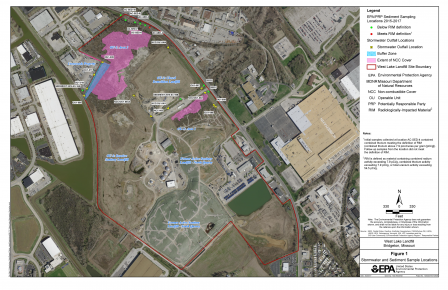West Lake Landfill Superfund Site, Bridgeton, Missouri - Fact Sheet, August 2017
Stormwater and Sediment Update
INTRODUCTION
In 2016, EPA directed the Potentially Responsible Parties (PRPs) at the West Lake Landfill to conduct stormwater sampling during and following rain events. These samples were collected by the PRPs, pursuant to enforceable administrative orders issued by EPA and analyzed for both landfill contaminants and radioactive particles. Additionally, the PRPs, EPA, and the Missouri Department of Natural Resources (MDNR) have each collected and analyzed numerous sediment samples from locations near the perimeter of the site. Based on these sampling efforts, EPA has concluded that stormwater runoff from the landfill is below site-specific, human health risk-based preliminary remediation goal (PRG) screening levels at the boundary of the site.
 Stormwater and sediment sample locations mapSTORMWATER SAMPLING SUMMARY
Stormwater and sediment sample locations mapSTORMWATER SAMPLING SUMMARY
The PRPs have collected more than 60 stormwater samples at the site since 2016. This sampling will continue and ultimately be incorporated into an OU-1 final remedy comprehensive monitoring plan. The Agency has summarized the stormwater data collected to date, and that summary is available online. The sample results show that the levels of radionuclides are below levels that would present a health concern. In addition, people are generally not being exposed to the stormwater runoff from the site.
Analysis of Stormwater Samples
Stormwater samples collected at the site are turbid and often contain higher levels of suspended soil particles. Samples with high turbidity typically have higher gross alpha activity. Testing for gross alpha and gross beta is often used as a screening tool to determine if additional laboratory analysis for specific radionuclides is necessary. Stormwater samples that the PRPs collected are therefore analyzed for the radionuclides specific to West Lake Landfill, namely uranium, radium, and thorium.
Preliminary Remediation Goals for Radionuclides
EPA has evaluated existing stormwater data as surface water and compared the results to human health risk-based PRGs prepared for the site. PRGs integrate site-specific information and the latest toxicity values to establish acceptable exposure levels that are protective of human health and the environment. All of the stormwater analytical results obtained to date at the site are below the conservative PRG screening levels for radionuclides, based on EPA’s calculations.
MDNR Stormwater Sampling
The PRPs and MDNR collected stormwater samples from the site during a heavy rain event on April 29-30, 2017. In analyzing its stormwater samples, MDNR compared the results to state and federal drinking water standards, known as Maximum Contaminant Levels (MCLs). Drinking water MCLs were used as a screening tool to determine whether additional isotopic analyses are needed. MDNR’s results indicated that gross beta, total uranium, and combined radium were below the corresponding MCLs. Gross alpha readings slightly exceeded the MCL, therefore MDNR ordered analysis for isotopic thorium. On Aug. 16, 2017, the state published its thorium results, concluding that “[t]he results do not indicate that the radionuclides in the sample are radiologically impacted material from West Lake Landfill.” Accordingly, MDNR recommended further monitoring and best management practices for stormwater to reduce sediment discharges from the site.
Future Actions Related to Stormwater
EPA, in coordination with MDNR, will continue to require the PRPs to monitor and manage stormwater at the site. EPA will evaluate additional data as they are reported and consider if additional stormwater and sediment actions are needed. EPA recently directed the PRPs to address additional outfalls and sampling locations in the stormwater monitoring plan. Once approved, the plan will be effective and enforceable until a final remedy is implemented for the site.
SEDIMENT SAMPLING SUMMARY
In January and March 2016, EPA obtained five sediment samples at the West Lake Landfill, while overseeing sediment sampling conducted by the PRPs. One of those samples, identified as SED4, was taken along the northeast edge of the West Lake Landfill. Analysis of the sediment samples collected indicated that the sample identified as SED4 met the site-specific definition of radiologically impacted material (RIM), which is 7.9 picocuries per gram (pCi/g) of combined radium and/or combined thorium.
On May 23, 2016, EPA required that the PRPs collect five additional sediment samples and resample the SED4 location. The PRPs and EPA collected sediment samples along the northeast edge of the site next to OU-1, Area 2. These sediment sampling results did not meet the definition of RIM at any location, including the resample of SED4. In 2017, EPA collected additional sediment samples at the site. These samples did not meet the definition of RIM in the sediment. The validated data from these sampling events are available online.
In summary, EPA has collected or required the PRPs to collect numerous sediment samples along the perimeter of the site. While one of the sediment samples collected initially met the definition of RIM, follow-up confirmation sampling in and around that location did not.
CONCLUSION
As directed by EPA, the PRPs have collected more than 60 stormwater samples at the site since 2016. In addition, MDNR has collected and analyzed stormwater samples. EPA has evaluated these stormwater data. Sample results show that the levels of radionuclides are below levels that would present a health concern. In addition, people are not generally being exposed to the stormwater runoff from the site. EPA, MDNR, and the PRPs have also collected sediment samples around the perimeter of the site. While one sample did initially meet the definition of RIM, confirmation sampling in that area did not. Based on the results, stormwater and sediment at the perimeter of the site does not pose an unacceptable risk to public health.
ADDITIONAL INFORMATION
Additional information regarding the West Lake Landfill Superfund Site is available online.
Additional information regarding MDNR’s work at the Bridgeton Landfill is also available online. Exit
These websites contain informational publications, technical documents and sampling results, and correspondence and other various documents related to work at the site.
